By Sammi Merritt
Believe it or not, the University of Illinois is regularly ranked as one of the most haunted college campuses in the United States.[1] From the on-campus burial of the first Regent, John M. Gregory, to the alleged tombstone beneath the Noyes Laboratory, spooky stories are abundant in campus folklore.[2] One of the most famous of these is the harrowing tale of the ghost that haunts the English Building.
Like most folklore, there’s no single correct version of this story. Regardless of the version told, the legend recounts the tale of a woman who died in the English building during its (alleged) use as a dormitory in the early 20th century, and who remains to haunt it to this day.
How she got there varies. One version claims that “a young lady committed suicide here after a love affair ended badly.”[3] Other versions describe her drowning herself in the pool due to “failing academic performance or unwanted pregnancy.”[4] Still others involve an act of seemingly random violence.
The types of poltergeistic mischief that the ghost causes in the English Building are similarly varied, depending on which version you hear. There are supposedly reports of “flickering lights and slamming doors,” especially in the room which was said to have been the one she lived in.[5] She’s been seen haunting the hallways in the English building and looking out the third-floor window: “Lights blink on and off, and doors fall open and slam shut, and spots get cold all by themselves, and wails are heard.”[6] Some say that she only haunts strict professors, and others that she will help you with your homework.
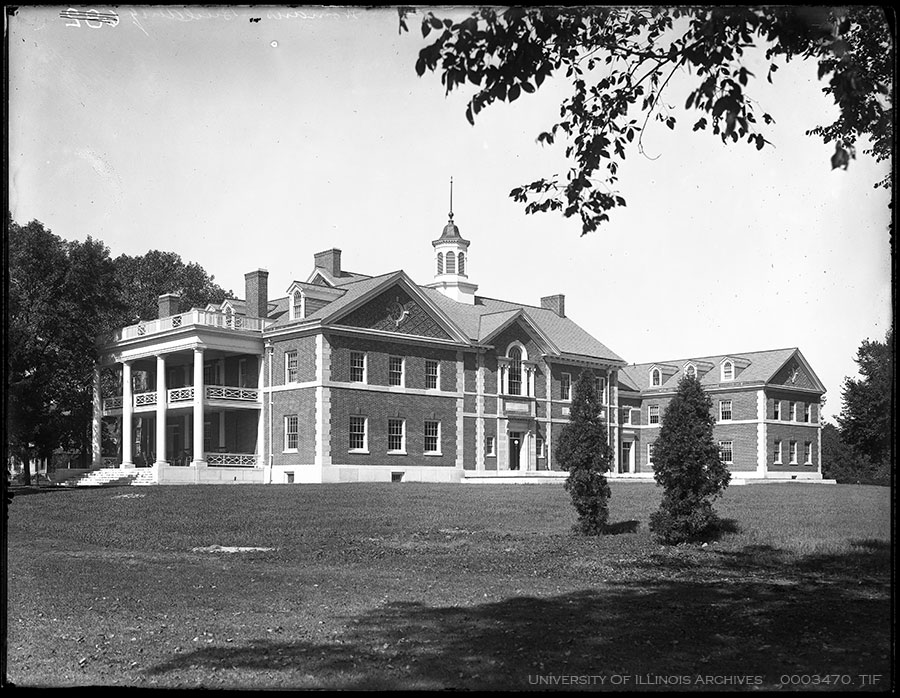
As early as 2001, the campus tour website provides the most detailed iteration of the story, in which a woman named Christine Moreno was stabbed in her bed on the top floor of the English building while her roommate spent the night on another floor. Although the roommate had stopped by in the night to grab her pillow, she did not turn on the lights for fear of waking Christine. The next morning, the roommate discovered the body along with a message written in blood that read “Aren’t you glad you didn’t turn on the lights?” This plotline and its jarring ending are seen repeatedly in other ghost tales, casting an air of healthy suspicion over its veracity.[7]
I have scoured the early student records of the University, and there is no evidence in the Archives that a student named Christine Moreno attended the University of Illinois between the years 1899 and 1981.[8] Of course, a later student could have injected their own name – or the name of a friend – into the story; but given that this event purportedly took place while the English building was used as a dormitory for women students, it would have had to occur between 1905 and 1919.
Despite this, there is no evidence to support the claim that this building was ever used as student housing.[9] It is true that the English Building was initially called the Women’s Building (or sometimes the Woman’s Building), but it housed recreational and educational spaces for the women on campus, not living spaces. The need for women’s housing on campus in the early 20th century was well-understood by the campus community, and several editorials discussing the nuances of the issue were published in the Daily Illini during these years. [10] A pamphlet published in 1874 addressing “Young Ladies at the Illinois Industrial University” referenced this need and indicated that the Boarding Department had arranged that a “neat, convenient and not expensive home is provided near the University building” for incoming women, though it does not specify where.[11] When the Woman’s Building was finally constructed in 1905, a description in the campus newspaper emphasized that “The building is probably not what a great many wanted. The dormitory that had been talked of so long has no place in it.”[12]
Despite the demand for women’s housing on campus, the first women’s residence hall – Busey Hall – was not built until 1917. Due to the need for more trained troops in WWI, however, even this was initially used as housing for incoming aviators in 1918 and then as a hospital in 1919. Campus maps through the years confirm that the first mention of a Woman’s Residence Hall is not made until 1915, where the future site of Busey Hall is marked.[13]
Resources which paint a definitive picture of the interior and uses of the Women’s Building are somewhat scarce, even in the Archives. This fact, combined with the prevalence of ghost stories, has likely led to the confusion over early uses of the structure. There are two contemporary sources which provide sufficient detail to discredit the idea that the Women’s Building served as a dorm, however. The first is President Edmund J. James’ 1920 work, Sixteen Years at the University of Illinois. The dedication of the original English Building coincided with the installation of President James in 1905, so his contemporary description of its facilities is reasonably trustworthy.[14] The second is a piece written by Isabel Bevier, the first professor of Household Science, about the history and use of the Women’s Building.
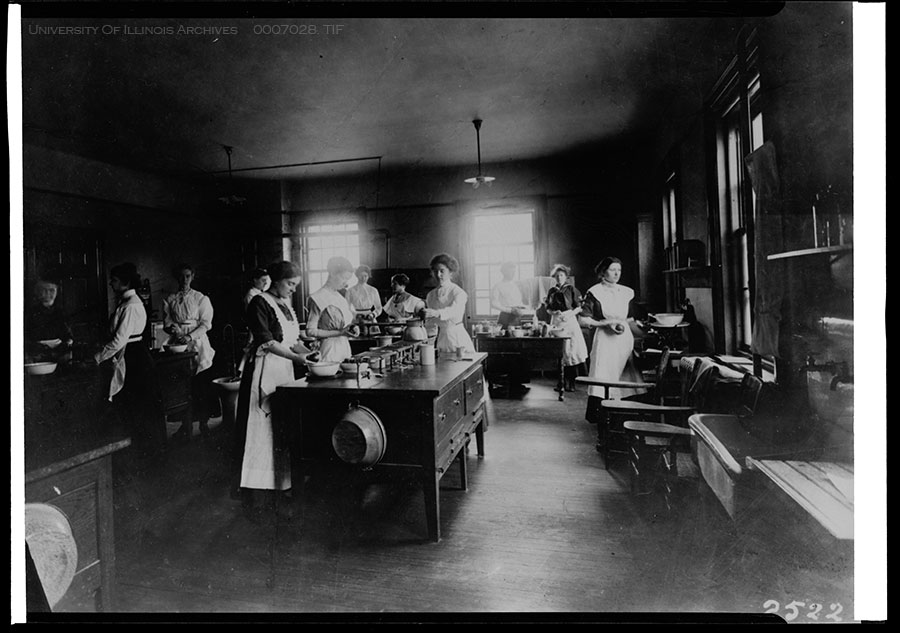
Each of these sources agrees that the North wing of the building housed the Department of Household Science, which focused on instructing women in all aspects of running a household. Classes were first held in the Woman’s Building on November 7, 1905, and courses in this curriculum often required the typical fixtures of residential living.[15] The archived Time Tables show that a 1914 course in “Household Management” included “Laboratory work in practise [sic] apartment,” and other laboratory-focused courses offered included “Dietetics” and “Problems in the Study of Textiles.”[16]
Equally important to campus administration in these early years was an appropriate space for the social lives of university women, namely one in which they could hold social events without the presence of men. The South wing of the Woman’s Building was reserved for this purpose, being comprised of parlors and conference rooms. Bevier proclaims: “Here will be the centre of the social life of the young ladies of the University.” [17] Note that while these rooms were provided for “social life,” they were not rooms where the women students lived while on campus.

In 1911, appropriations were made to expand the building, in a design which circumscribed the existing one. Citing a greatly expanded scope for the Department’s work, as well as in increase in the number of women enrolled, Bevier writes: “This new building is intended to supplement the old one, and to provide better and larger offices and quarters for the Department of Household Science, but it will also permit an expansion of the space devoted to social activities. Larger study and rest rooms are provided, together with a very spacious parlor and well appointed dining room.” [18]
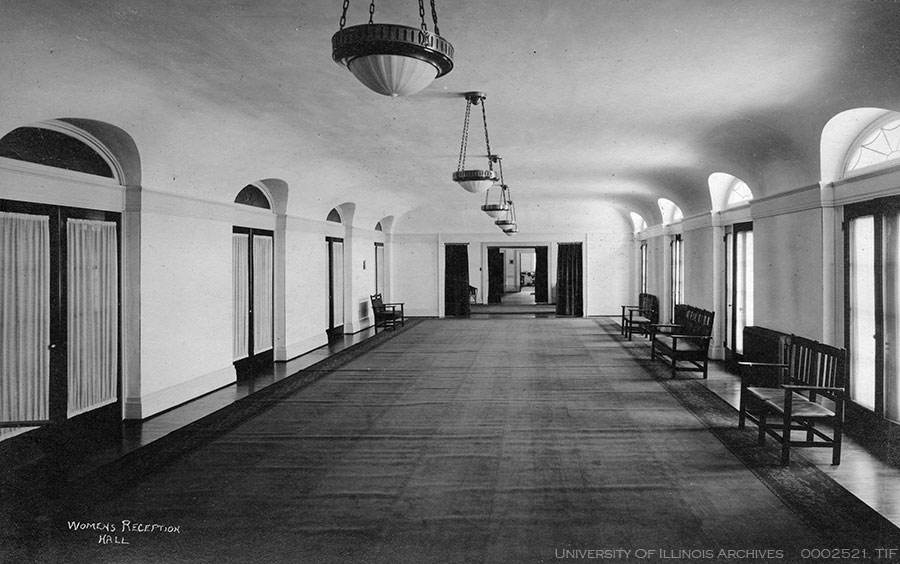
This same document describes the rooms added in the new expansion, floor by floor. The North wing, entirely dedicated to the Household Science Department, has in its basement “the kitchen for extension work with dining room adjoining and a well equipped laundry is to be installed in the new basement. The first floor contains two class rooms, a seminar room, a large exhibition room for illustrative material for work in house construction and textile fabrics, offices and cloak rooms. On the second floor are individual, diet, institutional and class kitchens, small and large dining rooms, chemical laboratory, offices and store room.” Perhaps most notably (for those keeping tabs on our ghost): “The third floor contains additional sewing rooms, offices, equipment for teaching home care of the sick and apartment in which the concrete problems of house construction, furnishing and household administration are to be studied.”[19]
Though in much less detail, James provides a description of the addition as well, writing that it “is a three-story fireproof building with basement… It has two halls for literary societies and a modern flat on the upper floor, and an institutional kitchen and large dining room on the second floor. There are also offices for the Dean of Women and the Director of the Courses in Household Science, laboratories, social rooms, and space for the expansion of gymnasium work.”[20]
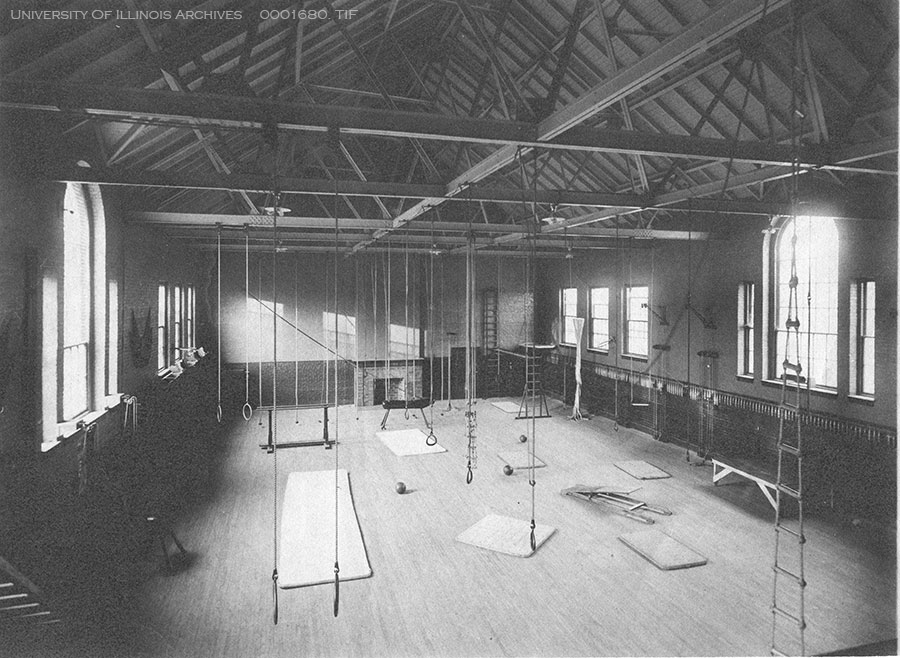
While each of these sources mentions an apartment/flat on the third floor of this expansion, the apartment was used as part of the Household Sciences curriculum rather than as a place for students to live or sleep.
One detail from the ghost story holds up to some scrutiny: there was originally a pool for women’s recreation in the building. James describes the facilities in Women’s Gymnasium, comprising the central part of the building in 1920: “On the lower floor there are the office of the Director of Physical Education for Women, a swimming tank, lockers, dressing rooms and baths. The upper floor is devoted to the main gymnasium, which is 92 by 50 feet.” [21] Unfortunately for the legend, however, there are no records of anyone ever drowning in this pool.
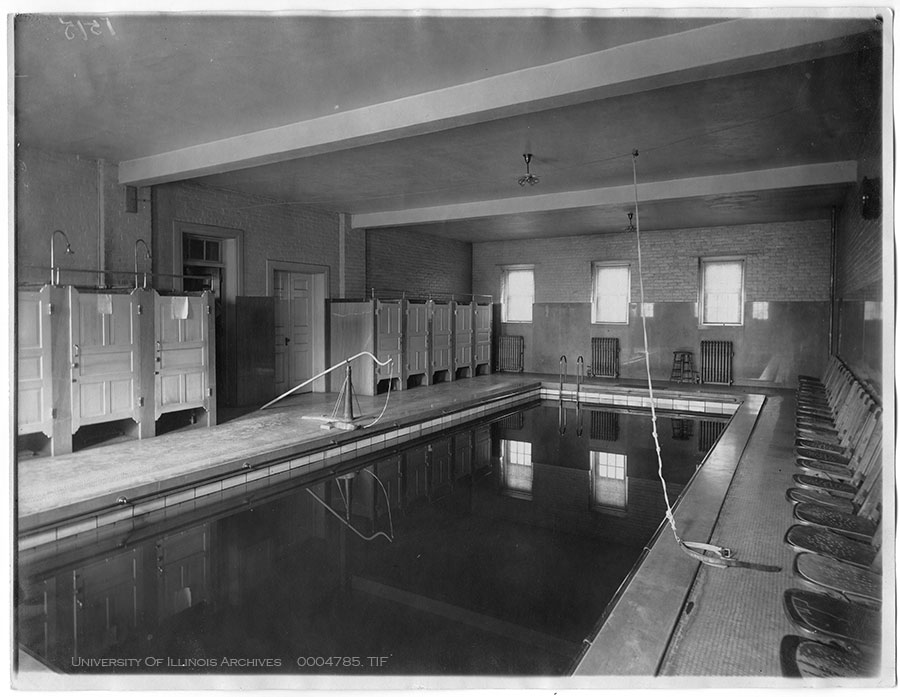
Despite its prominent position on the Quad, the history of this building is winding and often confused with that of other buildings on campus. While the ghost will likely continue to be the star of the English Building’s past, the true specter in this tale is the wispy history of the building itself.
If you’re interested in learning more about the University’s haunted history, stop by the Archives sometime to look at our ready reference material for “Myths and Legends at the U of I” and “Campus Ghosts.”
[1] Joseph Longo, “A University Horror Story: Campus Ghost Folklore,” The Daily Illini, October 31, 2016. https://dailyillini.com/news-stories/2016/10/31/university-horror-story-campus-ghost-folklore/.
[2] Mary Timmins, “Urban(a) Legends,” Illinois Alumni Magazine, Volume 26, Issue 1, Fall 2013. Page 24. https://uiaa.org/2013/09/26/urbana-legends/. Archived: https://web.archive.org/web/20210801000000*/https://uiaa.org/2013/09/26/urbana-legends/.
[3] Troy Taylor, “Ghosts of the University of Illinois in Champaign-Urbana, Illinois,” Haunted Illinois. 2002. https://www.hauntedillinois.com/realhauntedplaces/u-of-i.php. Archived: https://web.archive.org/web/20210801000000*/https://www.hauntedillinois.com/realhauntedplaces/u-of-i.php.
[4] Timmins, page 19.
[5] Taylor, “Ghosts of the University of Illinois in Champaign-Urbana, Illinois.”
[6] Timmins, page 19.
[7] D, “The Ghost in the English Building Tower!”, University of Illinois Campus Tours, 1997. Archived: https://web.archive.org/web/20060830033024/http://www.uiuc.edu:80/tours/quad/antratour/englishstrangebuttrue.html
[8] Student Directories, record series 38/1/806. Illio Yearbooks, record series 41/8/805. Student Ledger Card Microfilm, record series 25/3/4. Daily Illini Newspaper, record series 41/8/801. Course Registers, record series 25/3/801. Alumni Directories, record series 26/4/801.
[9] Dave Evensen, “The English Building was Never a Dorm,” LAS News, Winter 2014, page 4. https://web.archive.org/web/20151101105212/http://www.las.illinois.edu/alumni/magazine/articles/2014/english/.
[10] “The Dormitory Question,” Daily Illini, April 19, 1910. https://idnc.library.illinois.edu/?a=d&d=DIL19100419.2.20&srpos=8&e=——191-en-20-DIL-1-byDA-img-txIN-women%27s+dormitory———.
[11] Professor D. C. Taft, “Young Ladies at the Illinois Industrial University,” John M. Gregory Publication Scrapbook, record series 2/1/11, box 1, folder 1974-75.
[12] “The Woman’s Building: A Brief Description of its Departments and Uses,” The Illini, February 9, 1905. https://idnc.library.illinois.edu/?a=d&d=DIL19050209.2.1&e=——-en-20–1–img-txIN———-.
[13] “Campus Maps III, 1900-1919,” Ready Reference File, University Archives.
[14] Building and Statue Dedication Programs, record series 2/0/808
[15] Isabel Bevier papers, record series 8/11/20, box 11, folder ”The Woman’s Building and Addition, 1905-1908.”
[16] Time Tables, record series 25/3/804 box 1, Courses, 1914-1915, pages 219-224.
[17] Isabel Bevier papers, record series 8/11/20, box 11, folder “The Woman’s Building and Addition, 1905-1908.”
[18] “Measured and Found Wanting,” Isabel Bevier papers, record series 8/11/20, box 11, folder “The Woman’s Building and Addition, 1905-1908.”
[19] Isabel Bevier papers, record series 8/11/20, box 11, folder “The Woman’s Building and Addition, 1905-1908.”
[20] James, Sixteen Years at the University of Illinois, 86-87.
[21] Edmund J. James, Sixteen Years at the University of Illinois, Urbana: University of Illinois Press, 1920. 86. https://libsysdigi.library.illinois.edu/oca/Books2007-06/sixteenyearsatun00jameilli/sixteenyearsatun00jameilli.pdf.